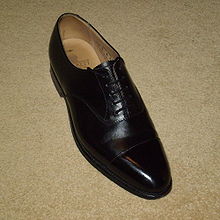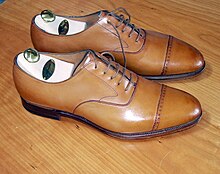An Oxford shoe is characterized by shoelace eyelets tabs that are attached under the vamp,[1] a feature termed "closed lacing".[2] This contrasts with Derbys, or Blüchers, which have shoelace eyelets attached to the top of the vamp. Originally, Oxfords were plain, formal shoes, made of leather but they evolved into a range of styles suitable for both formal, uniform, and casual wear. Based on function and the dictates of fashion, Oxfords are now made from a variety of materials, including calf leather, faux and genuine patent leather, suede, and canvas. They are normally black or brown, and may be plain or patterned (Brogue)
History
Oxfords first appeared in Scotland and Ireland, where they are occasionally called Balmorals after Balmoral Castle. However, the shoes were later named Oxfords after Oxford University. This shoe style did not appear in North America until the 1800s.[3] In the United States. Oxfords are called "Bal-type" as opposed to "Blucher-type". In France, Oxfords are known as Richelieu.
Oxfords were derived from the Oxonian, a half-boot with side slits that gained popularity at Oxford University in 1800.[4] Unlike early shoes, Oxfords were cut smaller than the foot. The side slit evolved into a side lace that eventually moved to the instep, as students rebelled against knee-high and ankle-high boots. The toe cap can either be lined with two narrow rows of stitching, perforated holes along the end cap stitching (quarter-brogue), perforated holes along the end cap stitching and on the toe cap (semi-brogue), or a semi-brogue with the classical wingtip design (full-brogue).
Terminology
The meaning of "Oxford" and "Balmoral" may vary geographically. In the United States, "Balmoral" is often synonymous with "Oxford". In the United Kingdom, "Oxford" often means any more formal lace-up shoe, including the Blucher and Derby. In Britain and other countries, the Balmoral is an Oxford with no seams, apart from the toe cap seam, descending to the welt, a style common on boots. Shoes with closed lacing (Oxfords/Balmorals) are considered more formal than those with open lacing (Bluchers/Derbys).
Women's wear
Women’s Oxford shoes are fashionable in the 2010s; however, this trend dates back to the 19th century.[citation needed] Borrowed from men’s footwear style, women’s Oxfords have received immense popularity since the 1920s including much attention in the 1940s–1950. The body of the Oxford shoe is created to appear as a flawless portion of leather, with a second leather piece forming the toe-cap. The differences in styles are generally due to the ornamentation: taller heels and designer colours. Since the current women’s oxfords draw ideas not only from the men’s shoe, but also from almost any conceivable source, the women’s variety has more freedom in terms of design, choice, and less adherence to tradition. This implies that Oxford shoes can fit almost every woman’s preferred style.[5]



Comments
Post a Comment